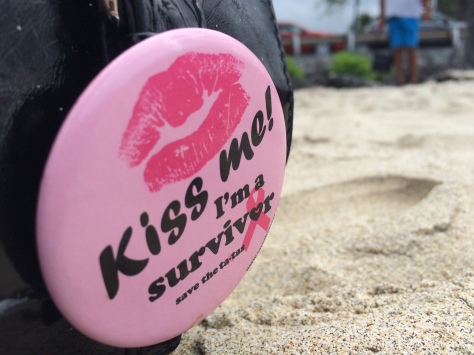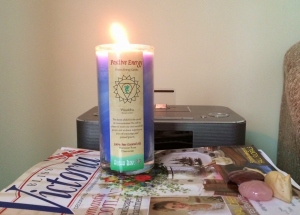Here it is, the fluffy post! Though not really: being able to influence how you look is part of self-determination, whether in treatment or not. It’s not vain so much as life-affirming. But before I leap on my gender soapbox, back to my tips!

Apologies for the slight graininess of the photo.
My eyes were pretty much lashless in this photo, and my brows were sparse at best. But this being my second time in treatment, I like to think I’ve got my makeup game down. Following is what I do for my (current) standard day look, along with links to what I use and other tips along the way.
First suggestion: Go to a Look Good Feel Better session. You’ll get tips on the safe application of makeup, along with head wrap techniques and some fun with wigs. It’s like a night in with the girls, complete with gab session and makeup application. And you receive a BIG bag of NICE makeup to keep. It’s one of the rare perks to this whole cancer thing. LGFB is where I learned to mix a 50/50 alcohol/water solution in a spray bottle and use it to disinfect my makeup brushes and pencil tips.
(NOTE: For my product suggestions below, I’ve linked you to Sephora’s website whenever possible. This is because Sephora is excellent about listing what products are made *without* — ingredients, like parabens, that many patients/survivors are trying to avoid using on their skin.)
OK. Find a spot with enough light, where you can sit down and be comfortable. Put some music on. It’s no fun if you’re rushing through; might as well enjoy the time and treat it like a little art session.
EYES: If I feel like I’ve got a little oil residue on my lids from last night’s makeup remover, I’ll dust some powder over my lids before starting with the liner. In this photo, I’ve actually got 2 shades of liner on. When I had lashes, I used to wear dark brown liner and black mascara — I liked the depth it provided. To simulate that, I’ve lined the whole lid with the brown and gone over the outer 1/3 of the line with black. I like to wing it up just a little at the outer corners, to simulate the shadow cast by the lashes that used to be there. Now, if you just line traditionally, the inner rim of your top lid is going to show because that’s where your lashes used to be. For the look I’ve got above, line the inner rims as you have the main line itself. You won’t poke yourself in the eye; just take your time. 🙂 This sounds intimidating, but with a soft, waterproof formula, it won’t hurt (see my picks below). Also helps to do these lines last, as your pencil tips will be dulled at this point. I don’t usually do anything to the bottom lash line, because I’m over-cautious about not drawing attention to my dark circles (more on them later). But if you do: use a very light hand, just line the outer 1/3, and smudge gently. Remember, naturally you would have fewer lashes down here anyway.
What I Use: The brown is Urban Decay 24/7 Glide On Eye Pencil in Whiskey. The black is Urban Decay 24/7 Velvet Glide On Eye Pencil in Black Velvet. Since the black I chose is matte (deep, rich, true matte), it flakes a little. If that might bug you, go for the standard 24/7 pencil, as linked above, in Perversion.
BROWS: I won’t lie, this takes practice, and you’ll get better with time. If you can, start filling in your brows before they become sparse, even if it’s just a light amount that you’re filling in. It’s the best way to get a feel for the shape and proportion of your brows. If you’re past that point, then you get to reinvent your brows. 🙂 Check Pinterest for brow shapes and styles you like, and give one a try. I tend to think of brows as branches rather than lines: they have their own width, their own taper, and their own bend at a specific spot. For me, the bend starts just before the outer corner of the eye. I like to use a pencil, for the control it gives and for its drier texture (I’m oily in the T zone area, in spite of the drying effects of chemo). My technique: Start with a few feathery strokes straight up at the inside end of where you’re drawing your brow. Using small strokes, draw a very light guideline along the bottom of your brow; stop where the brow will bend/arch. Draw more light feathery strokes up from that guideline, but at an angle. At the bend in the brow, draw your strokes at a downward angle instead, tapering the width of the brow. Use a cotton swab to fine-tune the shape and clean up edges as needed (this is why I like to use something that’s not waterproof).
What I Use: ZuZu Luxe Cream Brow Pencil in Russet (my wig is ginger red; this pencil is dark blonde/medium brown). If you prefer a gel and your skin is on the dry side, e.l.f. Studio Eyebrow Kit is not bad… and $3. 🙂 If you’ve got brow skills and are looking for something waterproof, there’s no beating Too Faced Bulletproof Brows. It’s worth the cost.
UNDEREYES: I had pretty bad dark circles even before chemo, and they haven’t gotten better! I make sure the area is moisturized — I’m using a separate eye cream these days. Give the cream 30 minutes or so to penetrate, if you can. I use my ring finger to swipe across the top of a concealer stick, picking up some color but not a whole lot. Then I **don’t** start in the inner corner like everyone says — then you’ve got all your product in the tiniest area that needs coverage. Instead I pat it on the middle of the undereye circle, just below the iris of the eye, and pat the color out in each direction, more toward that inner corner than the outer corner. This might not be enough — it’s OK to go over this with a second light layer of concealer; in fact it’ll look better than one thick layer. Use a little concealer brush for those inner corners this time, and if you have a little shadow on the sides of your nose, then use the brush to pat concealer there too.
What I use: Josie Maran Argan Creamy Concealer Crayon. Wonderful, hands down, in terms of coverage, blendability and moisturizing content. Just twist it up when the point wears low; you don’t have to sharpen it. I set all that undereye work with a dusting of powder, but not yet.
BLUSH: I’ve found nothing that looks as natural or flattering as a cream formula blush. And the cheeks can usually benefit from that extra boost of moisture. Swipe your middle and ring fingers lightly over the blush. Smile into the mirror — generally a good thing to do during treatment anyway — and pat and blend into the raised area of your cheeks.
What I use: I’m not thrilled with this one, but the price point is good. I’d like to treat myself to a more luxe brand once treatment is over. Sonia Kashuk Creme Blush
POWDER: *Now* I set what needs setting. Many powders available these days are mineral powders, and they have more coverage than a standard loose or pressed powder. I’m not wild about much coverage, but if you are, I’d go for that option over a liquid foundation. It’s just more versatile. With an eyeshadow brush that I use just for this part (any small fluffy brush is fine), I swipe across a pressed powder (you can also shake a little loose powder into the powder jar’s cap and dip the brush in) and gently brush over the areas where I’ve applied concealer. If I’m not wearing eyeshadow, I’ll go over my lids too, just down to the liner. I’ll also go around my brows. With a bigger powder brush that was actually made for this job, I’ll swipe over the powder again and brush over my T zone, and then very lightly over the rest of my face and about halfway down my neck (so there’s not a big difference in finish between my face and my neck).
What I use: e.l.f. Studio Translucent Mattifying Powder. Linking you to Target’s site for this one because it costs less here. It’s cheap and effective — normally those things are mutually exclusive, but not in this case.
Wait, what about eyeshadow? For me, eyeshadow is as much of a wild card as lipstick. I like to leave it till last because that gives me time to decide which color I want to use. My go-to is a shimmery champagne shade. (I would link you, but I’ve had it for so long I’m not sure I can find it again. Which is embarrassing from a germ-conscious standpoint, but in my defense, it’s a rollerball that I apply to my hand before picking up the color with a brush to apply to my lids. So I’m not dipping into an old pan of shadow. But yeah, I should ditch it… anyway…) Why? Because something light, with a little shimmer, will lift attention to the top lid — and away from even the slightest suggestion of a dark circle.
What I use: Apart from the rollerball shadow I need to toss, I like to experiment with mineral-makeup makers I’ve found on Etsy. Check through their policies and ask questions; they’re often happy to answer because they take pride in what they make. And the prices are fantastic! My two favorites are Eskimo Kissez and Tater Rounds Beauty. When budget allows, I also go for Urban Decay. The quality has always been consistently great.
There’s the whole shebang. If I can answer any questions about products or technique, please feel free to ask in the Comments. As detailed as this is, I’ve probably missed something. Comment if you have tips you’d like to share, too!







